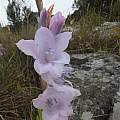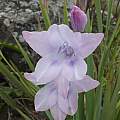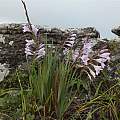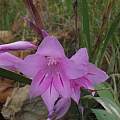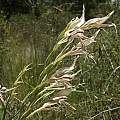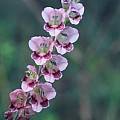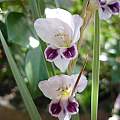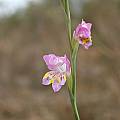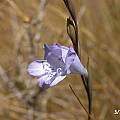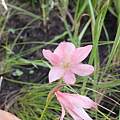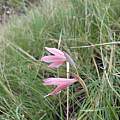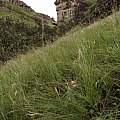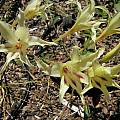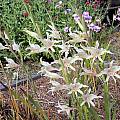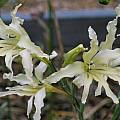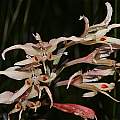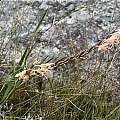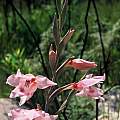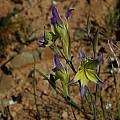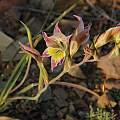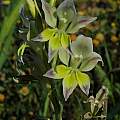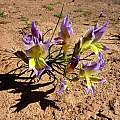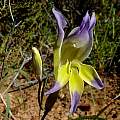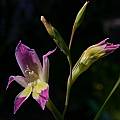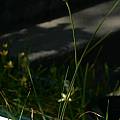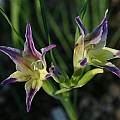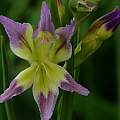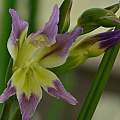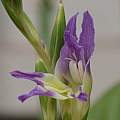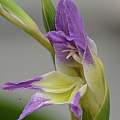From pale rose and mauve to salmon to screaming pink, this color complex offers many shades and the widest range of species in the color indices.
Page 1: G. anatolicus... Page 2: G. carmineus... Page 3: G. densiflorus... Page 4: G. gracilis... Page 5: G. maculatus... Page 6: G. nigromontanus... Page 7: G. phoenix... Page 9: G. vernus...
Gladiolus saxatilis Goldblatt & J.C.Manning, syn. Gladiolus lithicola Goldblatt & J.C.Manning, is a narrow endemic of the summer rainfall region where it occurs between Mariepskop and Graskop along the lower Drakensberg escarpment of Mpumalanga growing in shady places on sandstone rocks and cliffs of black reef quartzite. Growing from 45 to 80 cm high, it has six to ten fan like relatively broad (18 to 35 mm) soft textured leaves reaching to the base and middle of the spike and a slightly inclined spike of 9 to 16 relatively large pale pink to mauve unscented flowers. The lower tepals have weakly defined pale mauve, linear diamond shaped median nectar guides and the perianth tube is narrowly and obliquely funnel shaped. The floral bracts are purplish when young, becoming dry and rust-colored after flowering which occurs mid March to late April, possibly into May. Photos from Rachel Saunders.
Gladiolus scabridus is restricted to the mountains of northern KwaZulu-Natal and southern Swaziland where it grows at elevations of 1000 to 2000 m in well-drained, rocky habitats. Flowering from December to late January at lower elevations into February at cooler, wetter sites, it has an erect spike of 10 to 16 flowers. The unscented long tubed flowers are bright pink with a narrow white longitudinal zone in the lower two thirds and a narrow reddish streak in the midline. Photo taken by Rachel Saunders in KwaZulu-Natal January 2015.
Gladiolus sekukuniensis P.J.D.Winter is known from two sites in Sekukuniland, west of the Transvaal Drakensberg where it is found on alkaline soils in open woodland and flowers from March to April. It grows from .6 to 1 m and has linear leaves with a thickened and raised midrib and a spike of 8 to 17 flowers. Flowers are white or cream to pale salmon pink with a narrow, dark red, longitudinal median streak on each tepal except for the dorsal where the streak is sometimes incomplete or lacking. The lower tepals sometimes have a yellow streak in the center. Flowers are distinctively windowed (in profile there is gaping between the dorsal and upper lateral tepals) with the tepals unequal and narrowed below into claws with twisted and undulate tail-like tips. Photos by Rachel Saunders.
Gladiolus serpenticola Goldblatt & J.C.Manning is endemic to the Barberton District of Mpumalanga, South Africa where it grows in serpentine soils. It is tall (75-150 cm) with small pale pink flowers with pale mauve markings on the lower lateral tepals. Photos by Rod Saunders and Terry Frewin.
Gladiolus subcaeruleus G.J.Lewis grows on sandy loam and clay slopes in renosterveld in the southwestern Cape and flowers in the fall. It is described as having pale blue to mauve flowers with yellow transverse to spear shaped markings outlined in purple on the lower tepals. The dorsal tepal is hooded over the stamens. Photos taken by Cameron McMaster in the Overberg, Bot River and Napier show variations from the description.
Gladiolus symonsii F.Bolus is a montane species growing at 1900 to 3200 m on grassy slopes and cliffs in the Drakensberg range of KwaZulu-Natal and eastern Lesotho. Plants are 25-45 cm high and flower in early to midsummer, December and January. Flowers are bright pink to pale rose, whitish in the throat and relatively small with a short tube. Stems are unbranched and the spikes bear only two to four flowers. There are three leaves with the lowermost longest, sheathing the lower third of the stem. This species has rarely been collected and three plants were discovered by the photographers Rod Saunders and Rachel Saunders in an area that had burned on a dark day with a storm coming making it difficult to get good photographs.
Gladiolus undulatus is a late spring summer flowering plant found on marshy sandstone slopes in the northwest and southwest Cape. It has whitish to cream flowers with pink diamonds on the lower tepals. Although it is similar to Gladiolus carneus, it has a much longer tube with wavy tepals. Given the right conditions in some areas outside of South Africa this species has naturalized. The first three photos were taken by Mary Sue Ittner of flowers blooming various years in June in northern California. Photos 4-5 were taken in habitat by Andrew Harvie near Bainskloof. The last photo was taken by Rod Saunders.
Gladiolus venustus G.J.Lewis has flowers that are shades of purple to pink and sometimes dull yellow with yellow markings on the lower half of the lower tepals. It is widely distributed across the interior of the winter rainfall areas of southern Africa where it is found in dry habitats on clay and sandstone slopes. The primary pollinators are long tongued bees. It can be confused with Gladiolus scullyi and it has been included in that species at one time but it usually more colorful than that species which is usually greenish cream to yellow brown or beige and more highly scented. The dorsal tepal on Gladiolus scullyi is also more horizontal, inclined over the stamens and the upper two lateral tepals curve outward in an arc. But the distinctions are sometimes difficult to tell, especially in areas where they both grow. An example of this difficulty is shown in the third picture which I suppose could be either species. The first two photos by Mary Sue Ittner and Bob Rutemoeller were taken September 2006 in the Roggeveld. The third photo from Mary Sue Ittner was taken near Nieuwoudtville. The last two photos were taken by Cameron McMaster September 2011 near Middelpos in the Roggeveld.
Photos below were taken by Bob Werra.
Photos below were taken by Arnold Trachtenberg.
Page 1: G. anatolicus... Page 2: G. carmineus... Page 3: G. densiflorus... Page 4: G. gracilis... Page 5: G. maculatus... Page 6: G. nigromontanus... Page 7: G. phoenix... Page 9: G. vernus...
